5124 NE 34th Ave. - Portland, OR 97211-7452 - http://www.coasttrails.org - (503) 335-3876
NEWS RELEASE
NEWS RELEASE
FOR IMMEDIATE RELEASE: Thursday, July 31st, 2003
Media Contacts: Al LePage, Executive Director, National Coast
Trail Association, (503) 335-3876
Chris Hathaway, Lower Columbia River Estuary Partnership, (503) 226-1565
ext. 228
Brian Baird, Representative, US Congress, (360) 695-6292
Steve and Cindy Sheer, Alder Creek Kayak & Canoe, (503) 285-0464
"Portland/Vancouver" is Second Reach of Water Trail Traveled on "Bonneville to the Pacific!" Paddle Event
Paddle event continues two week journey of 140 miles traveling proposed Lower Columbia River Water Trail from Bonneville Dam to the Pacific to share water trail vision and highlight its natural beauty, rich history and culture.
Al LePage, Executive Director of the National Coast Trail Association (NCTA), continues traveling some 140 miles by kayak on Monday, August 4th from Government Island in the Portland/Vancouver area (the west end of the island is a state park managed by the Oregon Parks and Recreation Department). He will paddle over the first two weeks of August during the "Bonneville to the Pacific! event to promote public awareness about the proposed Lower Columbia River Water Trail. The new paddlers joining him along part of this second reach of the water trail, known as "Portland/Vancouver," will be Congressman Brian Baird from Washington and a guide from Alder Creek Kayak & Canoe of Portland, Oregon. They will paddle approximately 8 miles to Frenchman's Bar Park in Vancouver, Washington, leaving the from the dock just west of Tomahawk Island on Hayden Island about 12:30 PM. This is day three of the overall paddle event, this day actually begins on Government Island and ends at Frenchman's Bar Park to travel a total of about 15 miles during Monday, August 4th. The "Portland/Vancouver" section itself is about 20 miles in length and technically begins at the Parkerville Boat Ramp in Camas, Washington to end at Kelly Point Park in Portland, Oregon. An entertaining and educational public presentation will be given by LePage at the REI store at 1798 Janzten Beach Center in Portland, OR at 7 P.M. on Tuesday, August 5th. Another public presentation will be given by LePage with author Robin Cody at Lower Columbia Community College in Longview, WA at 1600 Maple Street at 6:30 PM on Thursday, August 7th in the Student Center conference room. Although guided paddling is not available to the public as part of the paddle event, the public can arrange tours along various sections of the trail through various local area businesses. Examples include Alder Creek Kayak & Canoe in Portland, OR; Scappoose Bay Kayaking in St. Helens, OR; and Skamokawa Center in Skamokawa, WA.
"The metro area of Vancouver and Portland," notes Al LePage, Executive Director of the National Coast Trail Association, "has shipping and industry on a scale that's grand! It's obviously a section of the trail that goes through an urban area, but if you know what to look for, it tells the story of the area's development. Just east of the Interstate 5 Bridge on the Washington side of the river is a park just to the east of the restaurant there. This is the historic site where the docks for the Hudson's Bay Company's Fort Vancouver once stood. Indeed, when public access is hopefully improved for paddlers to come ashore there, they will be able to visit Fort Vancouver and learn about the important role it played the settlement of the Oregon Country. By the way, did you know that Fort Vancouver actually transported Oregon Trail pioneers by boat down the Columbia River along the first reach of the water trail? Of course, the U.S. Army eventually arrived in Vancouver when the Northwest became an American territory, and so there's that story to be told at the Fort Vancouver National Reserve, too. When World War II came along Kaiser organized the building of ships for the war effort -- as one passes by Vancouver Marine Park one may still see the place where the shipyards once stood. Ocean-going cargo ships tell today's story about the area -- and the world -- as do the barges that travel up and down the river to the inland empire of wheat. There's lots to see -- and learn about -- on this reach of the water trail. There's certainly variety and some natural areas -- like the east end of Tomahawk Island -- mixed in for good measure. Just watch out for jets as they come in to land at Portland International Airport!"
The Lower Columbia River Water Trail is envisioned as a 146-mile water trail from Bonneville Dam to the Pacific Ocean that people in non-motorized boats can safely travel for day or overnight explorations. The water trail links together seven specific sections or "reaches" along the lower Columbia, each approximately 20 miles long -- about the distance of a typical two-day paddle. Beginning at Bonneville Dam and going downriver these "reaches" are, (1) The Gorge, (2) Portland/Vancouver, (3) Sauvie Island, (4) Kalama/St. Helens, (5) Longview/Rainier, (6) The Refuges, and (7) The Mouth. The journey along its length is spectacular and fascinating, a rich melange of gorgeous landscapes, historical sites, and working ports of call. This free-flowing section of the Columbia River flows through the magnificient Columbia Gorge National Scenic Area with its volcanic cliffs and waterfalls. It also travels along many wildlife refuges; waterfowl abounds at Sauvie Island and Ridgefield, there's Columbian white-tailed deer at the Julia Butler Hanson refuge, and one may enjoy the multitude of marshes and islands of the Lewis & Clark National Wildlife Refuge. Cultural and educational attractions along the river corridor include historical and maritime museums, abandoned riverfront towns, Forts Vancouver and Clatsop, and places where Native American's lived and worked in the past.
"Creating a water trail on the Lower Columbia River promotes tourism and provides an opportunity to enjoy the beauty of Southwest Washington," said Congressman Baird. "Along the route you pass through the Gorge, by waterfowl and white-tailed deer refuges, and the Lewis and Clark National Wildlife Refuge as well. This is truly a chance to showcase the many treasures of our region."
Brian Baird, U.S. Representative in Congress for southwest Washington, is an experienced kayaker and his office has participated in previous Water Trail Committee meetings. Whenever their schedules permit, Brian and his wife Rachel enjoy spending time outdoors in the Pacific Northwest. Some of their favorite activities in addition to kayaking include; camping, hiking, mountain climbing and skiing. They recently completed a successful summit of Mount Rainier - Brian's fourth successful climb to the top of this majestic peak.
"Safety and respect are two of the most important things to carry with you at all times," emphasizes LePage. "First, you shouldn't just throw a kayak or canoe into the Columbia and think you're ready. The Columbia's not a lazy river like the Mississippi; even in summer its waters are cold, its winds are strong, and tides effect the current all the way to Beacon Rock! You need to be prepared in terms of the necessary knowledge, skill-level, and proper equipment to do the specific stretch of river you'll be paddling. A lifejacket is an obvious piece of safety equipment, but I also invested in everything from a VHF radio, to speak with approaching ship captains and send distress signals, to a leash to attach my paddle to the kayak if I flip. Second, a lot of the shoreline along the water trail belongs either to individuals or the public agencies managing their lands for the benefit of wildlife. Those using the trail need to respect landowners and agencies alike by only using places where resting, camping, and access are allowed and obeying the regulations that protect wildlife and their habitat."
The Lower Columbia River Estuary Partnership (Estuary Partnership) has been coordinating the effort to develop the water trail since August 2001 under the direction of Chris Hathaway, Director of Watershed programs for the partnership. The work is being done through the Lower Columbia River Water Trail Committee, with technical assistance provided through the National Park Service's Rivers, Trails, and Conservation Assistance Program. The Committee was formed in September 2001 as a bi-state coalition of people with a diversity of interests and connections to the river. It includes representatives from state and federal agencies, local governments, environmental groups, paddling organizations and businesses, historical associations, economic development councils, trail associations, as well as interested citizens and others. The group works as an ad-hoc committee of the Estuary Partnership, a non-profit bi-state organization funded through the US Environmental Protection Agency and the states of Oregon and Washington. The committee's work has focused on planning, mapping and inventory of facilities for lauching, landing, resting, and camping, identifying local partners and gaining support for the trail concept, public outreach events, and developing a quality brochure.
Steve and Cindy Sheer, co-owners of Alder Creek Kayak & Canoe with Keith Jensen, began the business' instructional program in their garage in 1986 as family and friends would stop by, gear up, and hike down the trail to the Sandy River for an afternoon spent learning the art of flowing with the river. Steve and Cindy have over twenty years of experience as kayakers, both whitewater and seakayaking. They've given tours in Costa Rica, El Salvador, and Baja. Steve continues to provide tours on the Deschutes and John Day Rivers, and along the coasts of Oregon and Washington. Cindy's focus is working in the store, and her recent interests have been in racing outriggers in Australia, New Caledonia, and Hawaii. Their passion for the water, salt or fresh, can be summed up in their future desire to someday retire on their 35-foot sailboat!
LePage, is an avid hiker, cyclist,
and kayaker. He hiked in the footsteps and kayaked in the paddle
strokes of the 1805-06 Lewis & Clark Expedition along sections of both
the Washington and Oregon coasts during 1999 and 2000. He also retraced
-- dressed as the famed mountain man with replica gear -- the Jedediah
Smith Trail during 2000 some 200 miles over 3 weeks along the southern
Oregon coast on the exact calendar dates it was originally done by Smith
in 1828. He most recently retraced the historic 150-mile Alexander
McLeod expedition that first explored the central Oregon coast in 1826,
doing so by bicycle from Fort Vancouver to Lincoln City, and then on foot
-- portraying the not so famous Hudson's Bay Company Chief Trader
in authentic period clothing with replica gear -- from Lincoln City to
Florence, Oregon. LePage is also the first, and apparently only person,
to have ever hiked the entire 1800-mile length of the West Coast Trail,
having done the 400-mile the Oregon Coast Trail section in 1988, the 200-mile
Washington Coast Trail in 1992, and the 1,200-mile California Coastal Trail
in 1996. He also recently received the 2003 Doug Newman Award from
the Oregon Parks & Recreation Department for his efforts towards the
development of recreational trails in Oregon.
PHOTOS FOR NEWSPAPERS ARE DIRECTLY BELOW THIS PRESS RELEASE
#####
The National Coast Trail Association (NCTA) is a non-profit organization working to "Keep The Coast For Everyone" through recreational trails, public access, and the preservation of historic and natural environments. It is also a member of the Lower Columbia River Water Trail Committee. Visit www.coasttrails.org for organizational and special event details.
Alder Creek Kayak & Canoe is a community business selling paddle sports gear, providing training, and offering tours along sections of the Lower Columbia River Water Trail. They are members of the Water Trail Committee, especially involved in mapping and inventory work. Visit www.aldercreek.com for further information.
The Lower Columbia River Estuary Partnership is a non-profit bi-state organization working in Washington and Oregon to protect and restore the nationally significant lower Columbia River esturay with on-the-ground improvements, education and information programs. It coordinates the efforts of the Lower Columbia River Water Trail Committee. Visit www.lcrep.org for further information.
--------------------------------------------------------------------------------
The following six photos may be used by the newspaper print media
and cropped and color-balanced as necessary.
They are high resolution photo images of 300 dpi suitable for print
quality.
Please credit the National Coast Trail Association.
"Portland/Vancouver" is the second of seven"reaches" of the Lower Columbia River Water Trail.
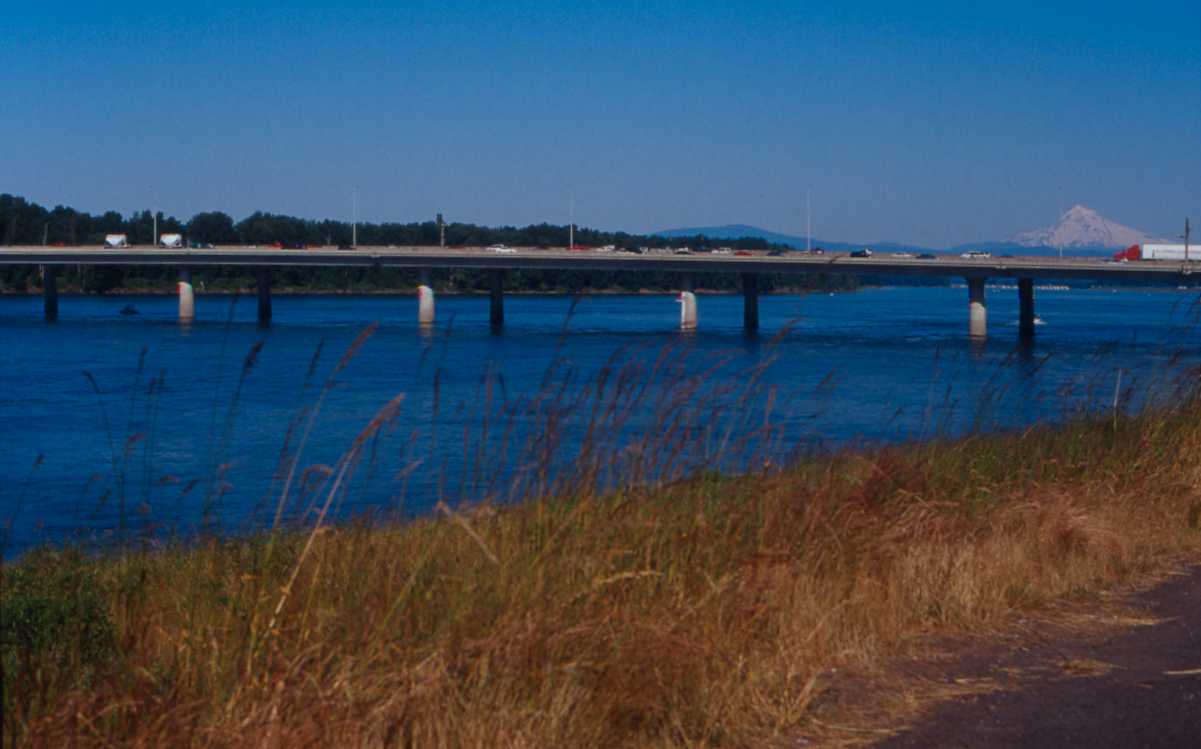
The I-205 Bridge spans the Columbia near Government Island where paddlers can camp in an urban setting.
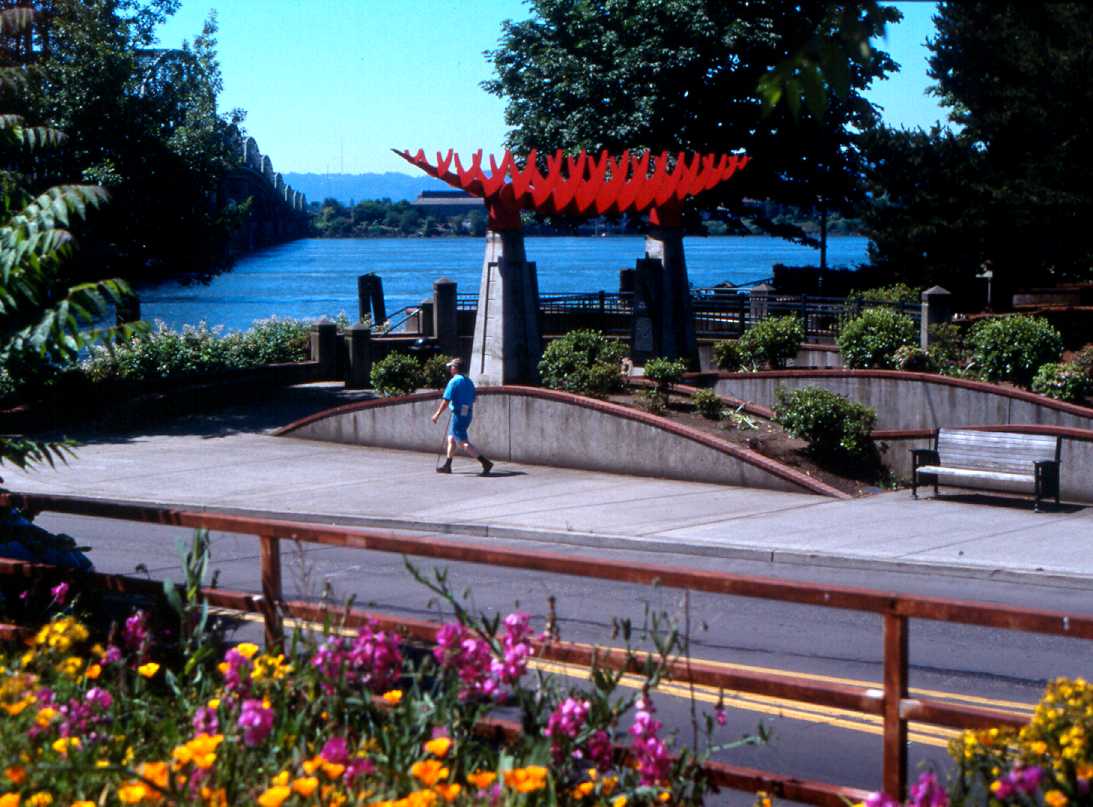 ----
----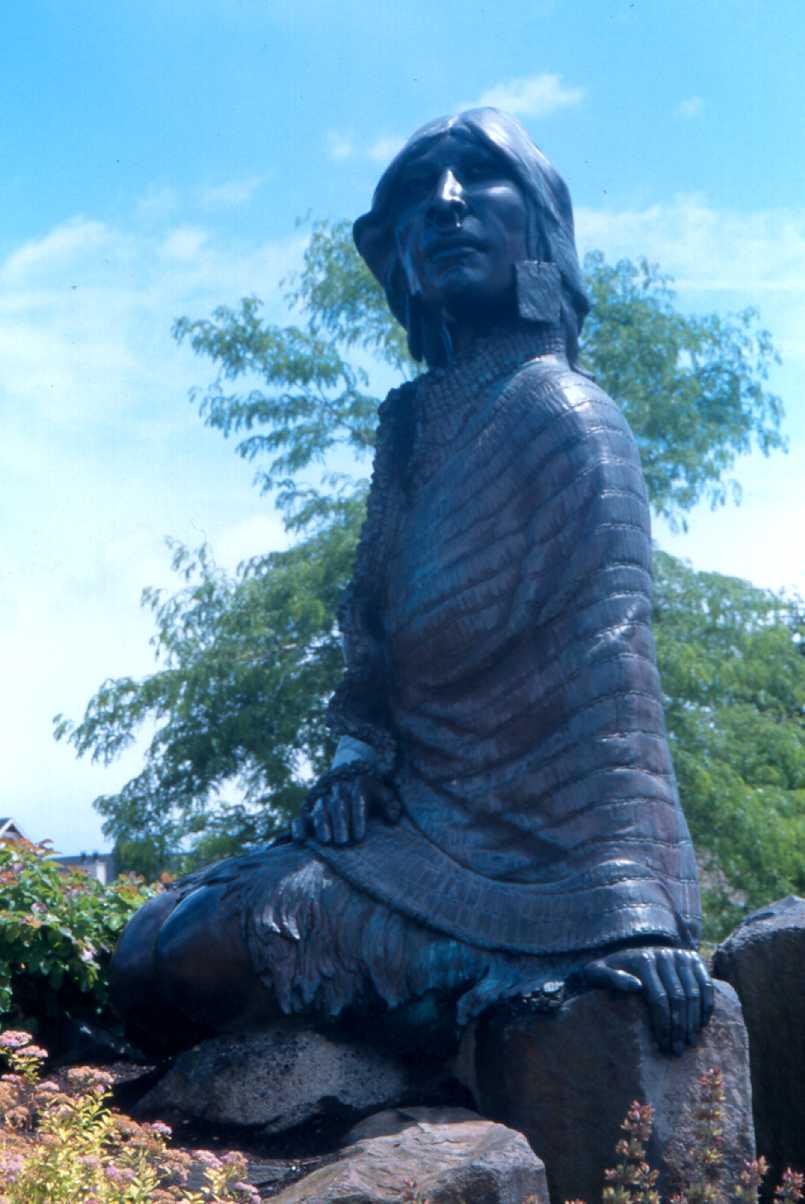
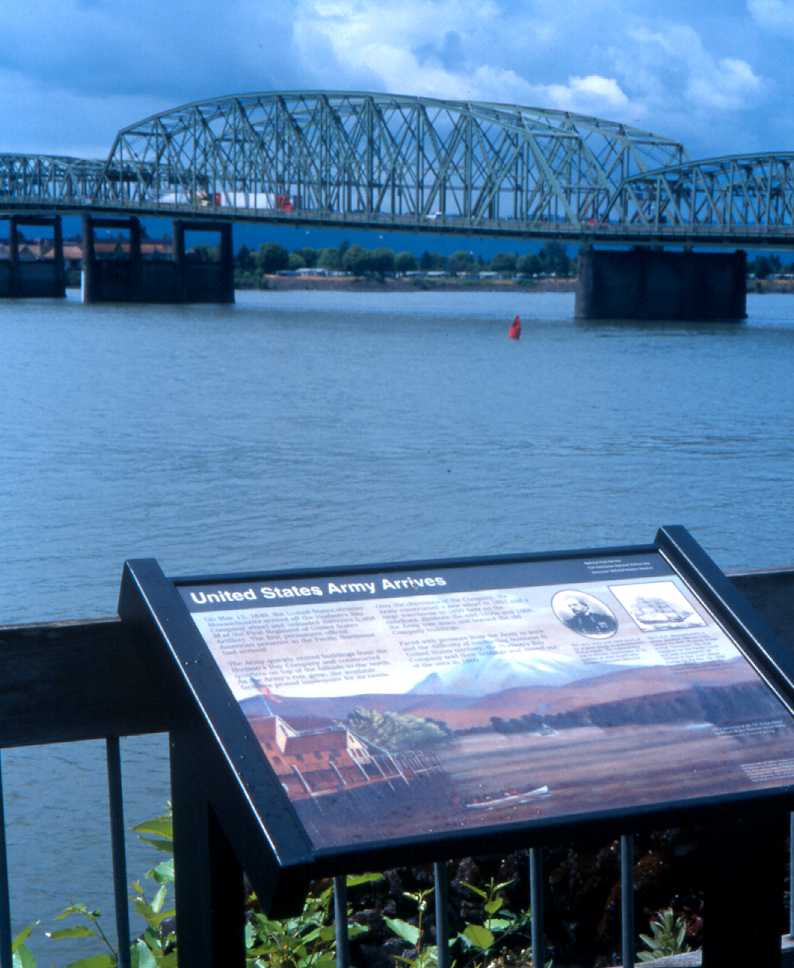
The Columbia has a rich history to share along its shores! Besides Lewis and Clark there's . . .
(Left Photo) "Boat of Discovery" commemorating Lt. Broughton's
exploration
of the lower Columbia in 1792 with George Vancouver's expedition.
(Right Photo) Statue of an Indian woman from the past looking west upon the Columbia.
(Bottom Photo) Interpretive Signage highlighting the arrival of the United States Army at Fort Vancouver.
All photos are along the walkway in Vancouver, WA with the I-5 Bridge in the background.
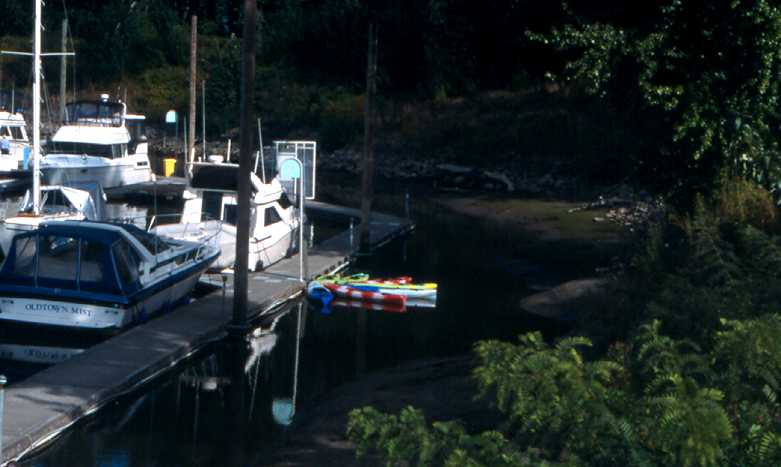 -----
-----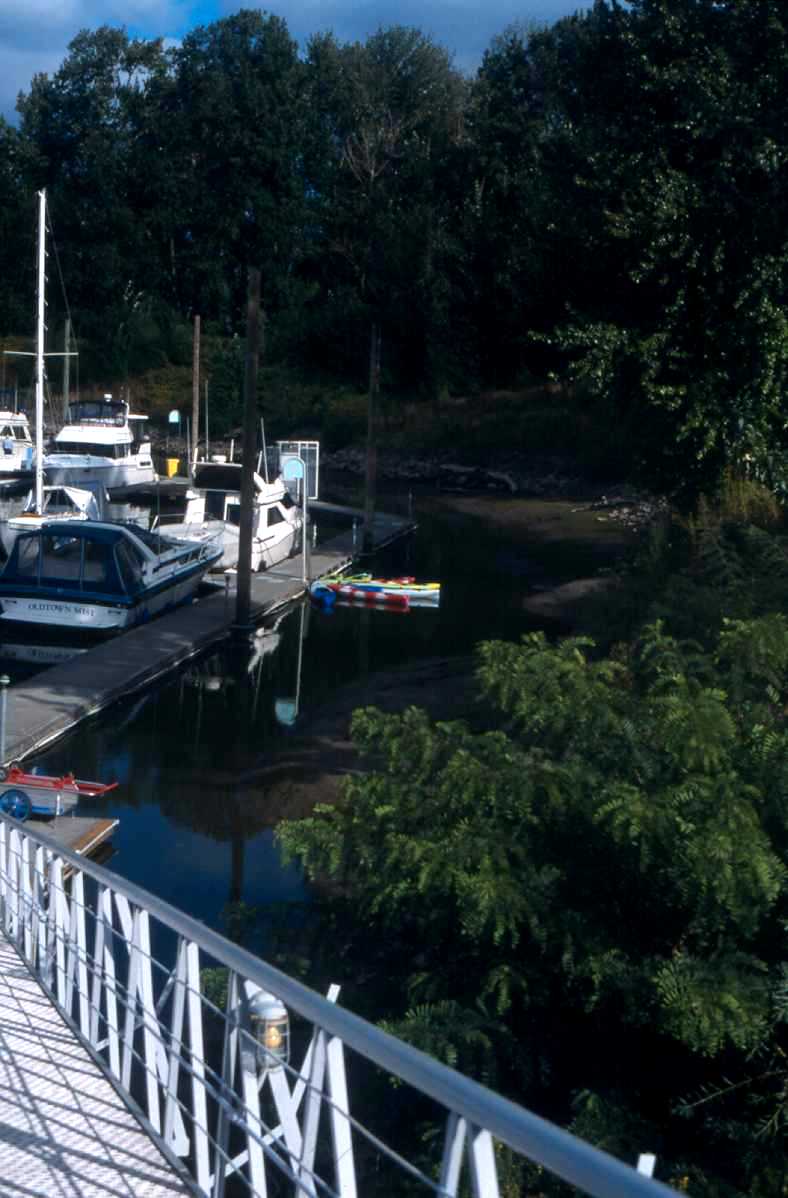
Kayaks at one of the docks used by Alder Creek Kayak & Canoe
in Portland, Oregon
where this local business accesses the "Portland/Vancouver" reach
of the water trail.